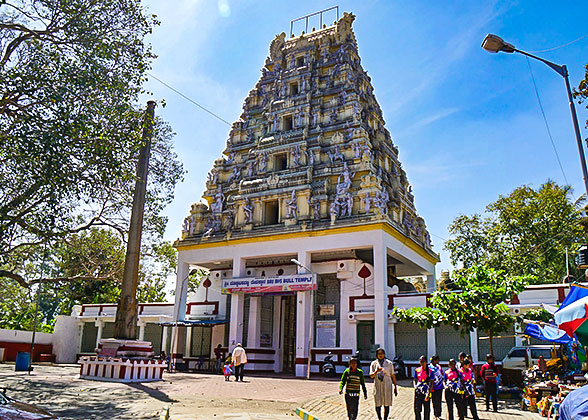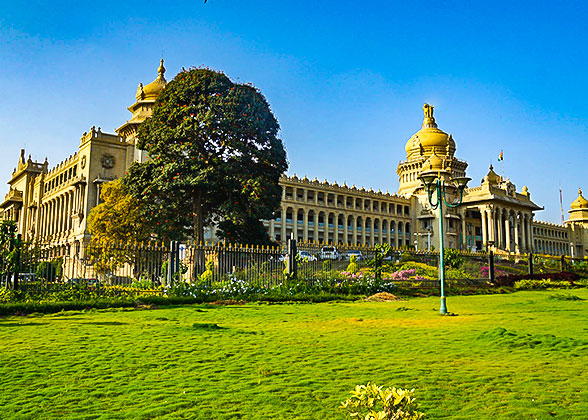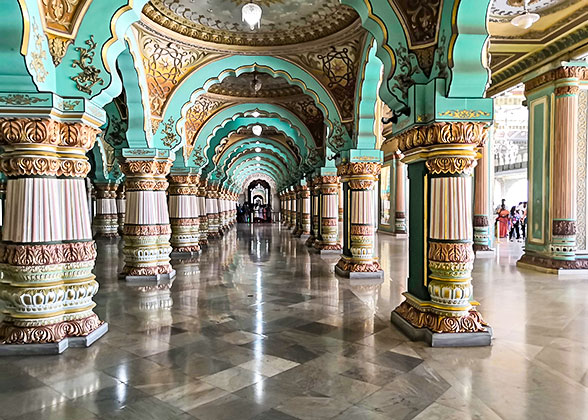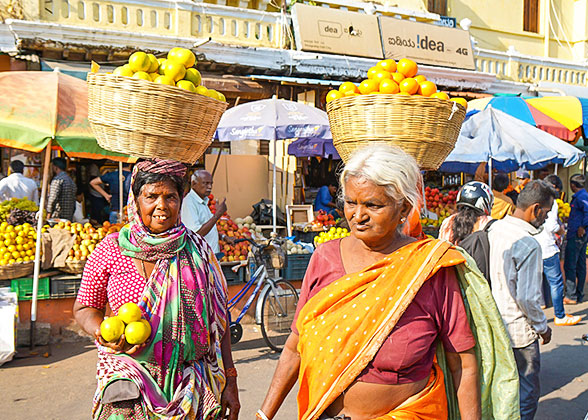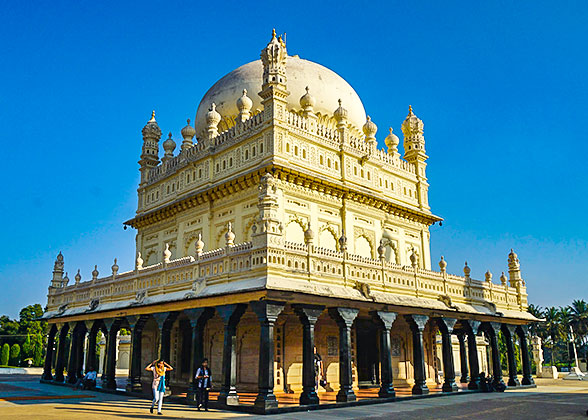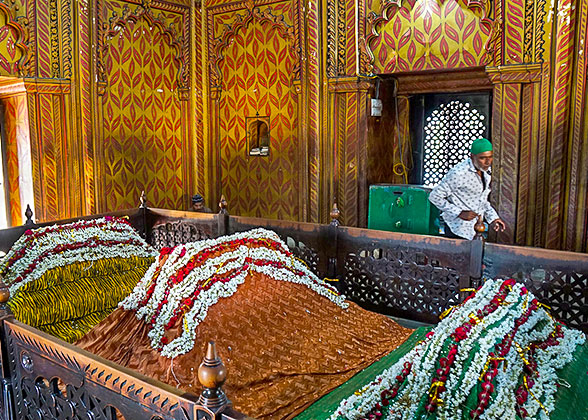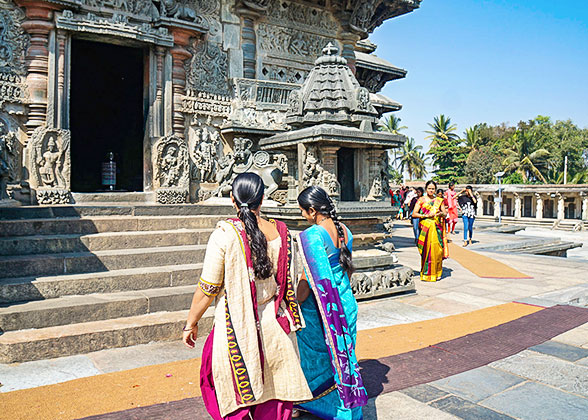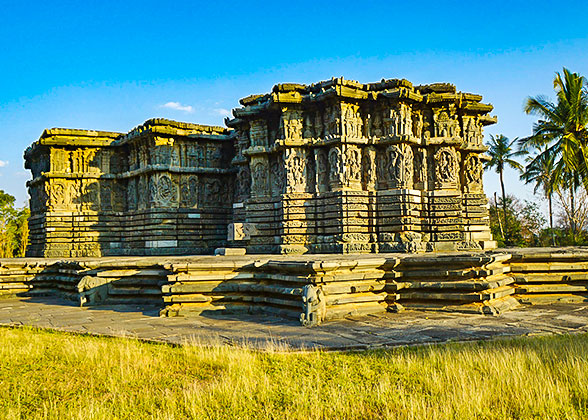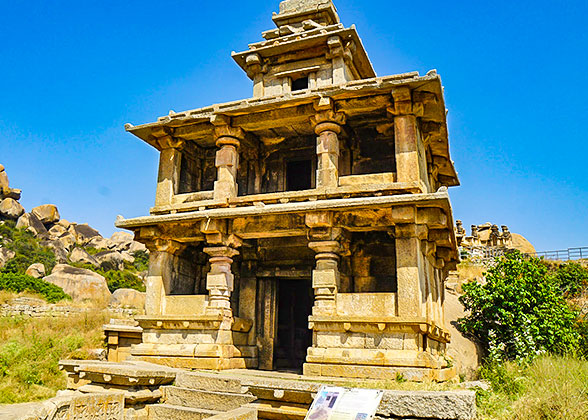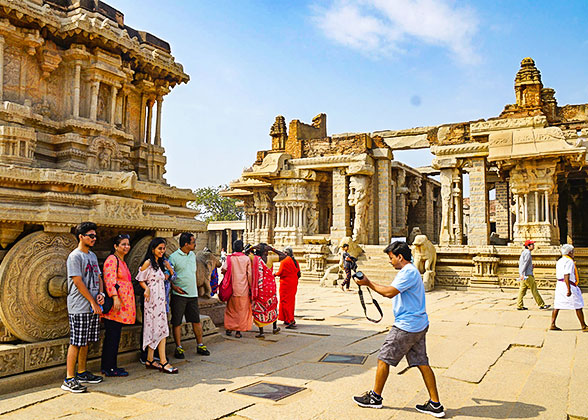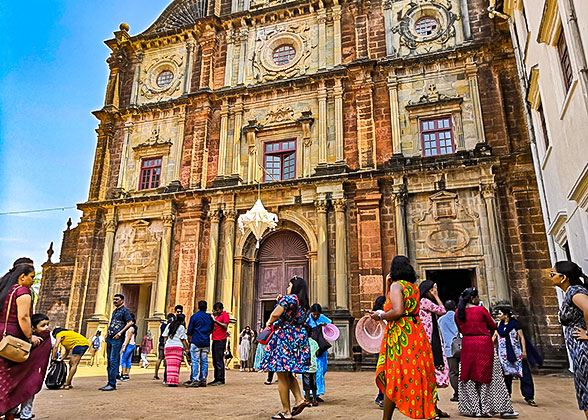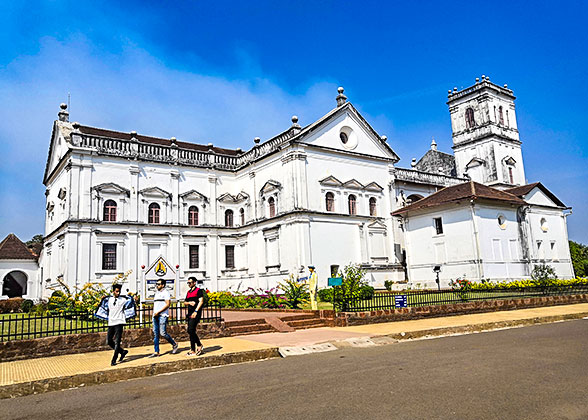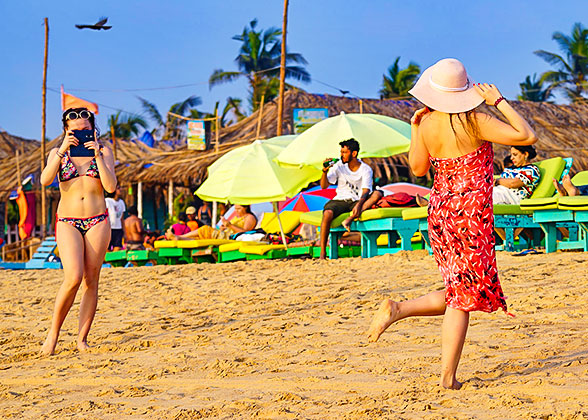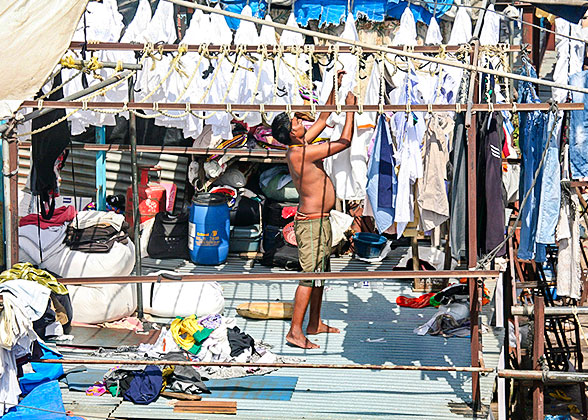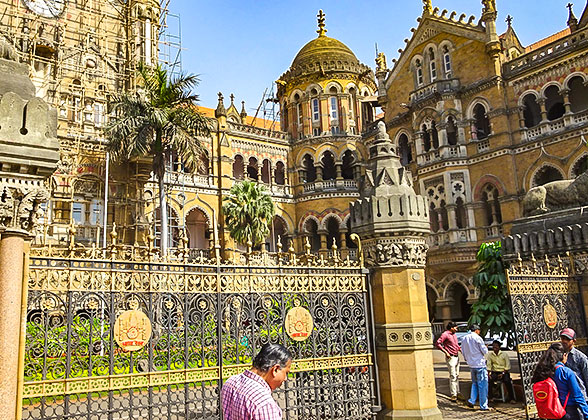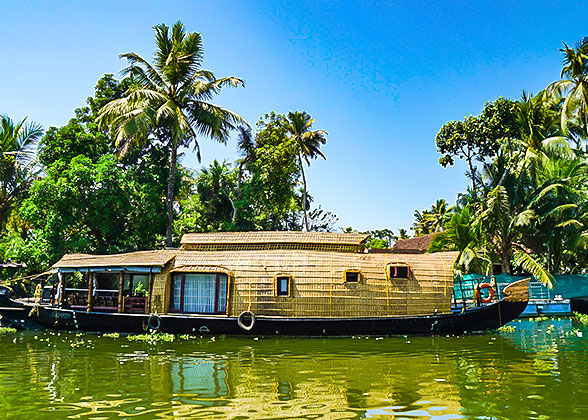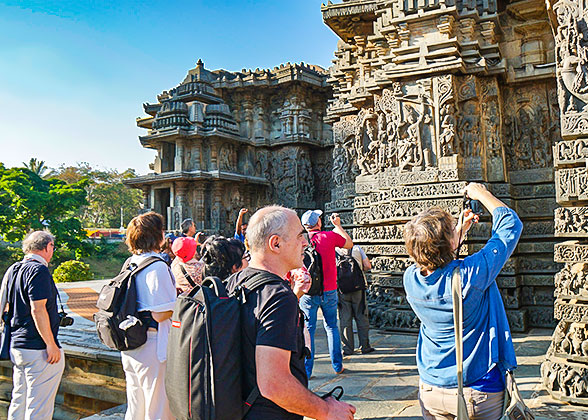Day 1: Arrival in Bangalore (Bengaluru); Airport Pick-up
Arrival Note: Welcome to India! Upon arrival, our representative will greet you at the Bangalore Airport and our private car with chauffeur will be ready to transfer you to the hotel for check-in. For the rest of the day, you can rest in the hotel to beat jet lag or take a walk around the area.
► Free Afternoon Suggestion:
1. For clients who select ITC Windsor Luxury Collection Bangalore, you can walk along the Sankey Road for about 20 minutes to Indira Gandhi Musical Fountain Park. Or, take a taxi to visit the Bangalore Palace, which take about 5 minutes but 25 minutes if you walk there. The most attractive aspect of the Bangalore Palace is the fusion of Tudor architectural style with the streetscape of the city. The main building is made of wood and the highlights is the carvings and paintings inside.
2. If you stay at Radisson Bengaluru City Center, then 3-minute walk can take you to Gurdwara Sri Guru Singh Sabha, an important religious site of Sikhism. The kitchen, called Langer, provides free food to all visitors because Sikhs believe that providing free food to all those in need is the best way to express dedication and kindness, as everyone is equal.
3. Bangalore is the center of information technology in India, with several top universities, such as Indian Institute of Science,Inter-University Centre for Astronomy & Astrophysi. If interested, you can order a taxi or tuktuk to have a look.
|
Day 2: Bangalore Sightseeing & Drive to Mysore
Morning Sightseeing in Bangalore: After breakfast, your guided tour will start from the Cubbon Park, a landmark situated at the heart of Bangalore. Founded in 1870, this picturesque 'green lung' of the city is not only rich in plants, but also has a long history. Next, we will visit the Lal Bagh, a botanical garden with more than 1,800 species of plants. Then we will head to the Nandi Temple (Bull Temple), a Neo-Dravidian-style temple built in 1537. You will see a huge statue finely carved in the shape of the sacred bull. In the noon, our Bangalore tour will end at the Vidhana Soudha, an ornate white building that houses the offices of the State Legislature. Afternoon Drive to Mysore (185 km; 3.5 hours): After lunch, we will set off to Mysore by our private car. Before dark, we will arrive at the local hotel to check in and rest. Meals: Breakfast
|
Day 3: Mysore Highlights: Mysore Palace, Holy Hills and Temples
Sightseeing Activities: This morning, our guide will first lead you to visit the Mysore Palace, one of the largest palaces in India. This Indo-Saracenic palace is a combination of Hindu, Muslim, Rajput, and Gothic architectural styles. We can see a lot of treasures and various iron decorations inside. Not far from the Palace, we will show you the Devaraja Market. Next, we will proceed to the Chamundi Hill, one of the eight holiest hills in South India. On the top of the Chamundi Hill, you will be guided to visit the Chamundeshwari Temple dedicated to the Goddess Chamundeshwari. From here you will get a panorama of the picturesque hill. On our way back to downtown Mysore, we will stop to see the massive Nandi Bull statue carved out of a piece of granite. In the afternoon, the guide will accompany you to visit the Srirangapatna, a historic town located on a river island. We will first visit the Sri Ranganathaswamy Temple, a Vaishnavite shrine of significance in South India. Later, we will head to the Gumbaz, a magnificent mausoleum built by Tipu Sultan in 1792 for his parents. It is located in the center of a cypress garden. Our last stop today will be the Daria Daulat Bagh, an 18th-century summer palace featuring Indo-Saracenic structures and housing the famous painting ' Storming of Srirangapatna'. Mysore Palace Devaraja Market
★ What Makes Us Different?Have you ever seen an Indian woman holding a huge basket full of stuffs over their head in news reports or documentaries? Today you can see it at Devaraja Market as we believe there is nothing better than a local market to know about the lives of local people. It is a market for agricultural products and flowers, established since the Tipu Sultan age in the 18th century. Here you can see various fruits and vegetables, curry powder and spices, as well as the colorful pigment powders, all of them are piled up by the vendors like small hills, or in other words, like flat pyramids. From the day it was put into use, the market has provided all the necessities of life for the locals. Covering an area of over 4050 square meters, there are approximately over 800 stores. In addition to daily necessities, there are fresh roses, lotus flowers, jasmine flowers. Mysore people like to string flowers together, hang them on their bodies and homes, or offer them to gods. If you'd like to try something interesting, you can buy a string of jasmine flowers and take a stroll around. Meals: Breakfast Gumbaz Mausoleum Inside of the Mausoleum
|
Day 4: 5 Hours’ Drive to Hassan with Visit to Belur & Halebid
Sightseeing Activities: Today, we will take a road trip to Hassan by our private car. On the way, we will stop at Belur and Halebidu, twin towns reputed as UNESCO World Heritage sites. First, we’ll visit Belur from its 13th-century Chennakeshava temple complex, which perfectly exhibit the Hoysala architecture. The complex includes many exquisitely-carved temples, such as the Chennakesava Vishnu Temple, built to commemorate a battle victory. Next, we will drive to Halebid to visit the Kedareshwara Temple, as well as the Hoysaleshawara Temple which houses two stupas dedicated to Shiva lingas. After the visit, we will continue our drive to Hassan and check into the hotel. The Exquisitely Carved Patterns on the Walls Upon arrival at the Belur Temple complex, everyone will be impressed by the exquisite carvings and grand architecture. Even the carvings on the exterior walls of the temple were lifelike, reflecting the prosperity of religion and the richness of the people's spirit at that time. The carving on the exterior wall of the main hall is divided into ten layers. The first and second layers consist of hundreds of war elephants and male lions, the third and fourth layers are various floral carvings. Dancers with various instruments are put on the fifth and the sixth, while the hollow carvings and temples are on the next two layers. The higher the place, the closer it is to the gods. The stories of the gods in Indian mythology is carved on the ninth layer, and the stop layer is filled with dancers of various postures, among those, the most famous is the S-shaped dancer. She holds a drum in her hand, and the sculptor perfectly created an S shape with her body, waist, arms, and feet that conforms to modern aesthetic principles, demonstrating people's ultimate pursuit of beauty at that time. Accompany with our guide, you will find more interesting and stunning carvings here. Meals: Breakfast Chennakeshava Temple Kedareshwara Temple
|
Day 5: Drive 7h from Hassan to Hosapete & Visit to Chitradurga Fort
Let's move on to Hosapete, and visit Chitradurga Fort on the way. It is a stone fort built from the 17th century when Hyder Ali and Tipu Sultan ruled this region. If you want to try some local food, your driver will give you some suggestion. Continue driving for 25 minutes to Hampi and stay at the hotel for two nights. Meals: Breakfast Chitradurga Fort Vittala Temple
|
Day 6: Full Day Excursion to Hampi Ruins
Hampi Ruins is another UNESCO World Heritage Site, where full of old temples and ancient buildings. First, visit Virupaksha Temple, it is the oldest temple of Hinduism and the most representative one. Then we will move to the 16th-century Vittala Temple featuring a Garuda shrine in a form of stone chariot. Later, you will continue to Hazara Rama Temple to view the relief and carvings portraying the legends of the epic Ramayana. We will also see the 15th-century Elephant Stables, a rectangular building in Indo-Islamic style, the Queen's Bath with a history of more than 500 years, and the Ramachandra Temple. Then final stop for today is the Lotus Mahal. The Best Preserved Temple in Hampi Virupaksha Temple is the oldest and best preserved temple in Hampi, with a history dating back to the 7th century and fortunately survived from the Muslim's invasion in 1565, it has been the most sacred holy site for centuries. Its architecture is considered a mystery of mathematics and architecture with a 50-meter tall tower gate and triangular patterns and Fibonacci sequence on the dome, which will cause visual changes when visitors look up. Besides the dazzling carvings, people can see two holy elephants inside. Every morning at 8 o'clock is the busiest time of the temple when the temple elephant return after bathing in the river. The faithful followers and children will stay around it in the hope that the elephant can touch or kiss their heads, which they believe will bring them good luck and wealth. Every February, the annual Virupaksha Temple Festival is held, you can feel the enthusiasm of the locals if you happen to be here. Meals: Breakfast Virupaksha Temple Holy Elephant
|
Day 7: Drive 4h to Badami with Visits to Aihole & Patadakkal
After breakfast, we will drive to Badami and visit Aihole on the way, it is an ancient temple complex. With your guide, you will see the 7th-century Kontigudi Group with Trimuty idols and the Galaganatha Group with the statues of Lord Shiav. We will also visit the 5th-century Lad Khan temple carved with floral elements, Durga temple aka, the cave temple Ravana Phadi and the Jyothirlinga Group. Next we will stop for a guided tour at Pattadakal, a UNESCO World Heritage site featuring the Hindu and Jain temple complex from the 7th and 8th centuries. There are many famous temples like Virupaksha Temple, Sangameshwara Temple, Chandrashekhara temple, etc. Stay at a nice hotel at Badami.
What to Visit in Pattadakal Complex
Pattadakal complex was built during the Chalukyas Dynasty from the 7th to 8th centuries AD. At that time, Patadakal was the second largest city in India, where many major ceremonies of the Indian royal family are held, such as coronation ceremonies. Indian temples have their own distinct characteristics, the main hall were usually built on a platform with long steps and to reach, the porch and the railings on both sides were all exquisitely carved with war elephant, flowers and myths.
The Pattadakal complex involves nine Hindu temples and one Jain temple. Among those, the oldest temple is Sangamesvara Temple built in 8th century AD by King Vijayaditya. And the most famous temples are two-sister temples Mallikarjuna Temple and Virupaksha Temple. Besides all these prestigious temples, our guide will also show you more buildings which are scattered around, such as Kadasidheshvara Temple, Galaganatha Temple, Kashivishvanatha Temple. etc. Some of them blend the architectural styles of North and South India, while the overall complex shows people the highest achievement of Chalukyas Dynasty.
Meals: Breakfast
|
Day 8: Badami Visit & Drive 2h to Hubballi
Take a visit to Badami Cave Temples, Badami Fort and Sri Bhootanaatha Gudi after breakfast. Then drive for Hubballi. On the way, you can ask for stops at places you are interested. Upon arrival, visit Indra Gandhi Glass House, Unkal Lake and finally get to Nrupatunga Betta, a serene hill place for watching birds and sunset. Stay overnight at Hubballi.
See Hubballi from Top
After a 7-day journey, it's good to take a leisure walk and relax in the nature. Nrupatunga Betta is a park located on a small hill, offering a panoramic view of the city. If you travel with kids, it's a good idea to buy some snacks and drink to have a picnic here. After visiting, our driver will transfer you back to your hotel where you can have your dinner.
Meals: Breakfast
|
Day 9: Private Transfer to Goa in 5 Hours
Goa brings the whole journey to a higher climax. After breakfast, a driver will drive you to Goa and check in at the hotel. Then you will be free to enjoy your leisure time. The city has been ruled by Portugal for hundreds of years so that the buildings are full of European style. In addition, there are a lot of beautiful beaches around the city.
Meals: Breakfast
|
Day 10: Goa Sightseeing: Churches and Monuments
Sightseeing Activities: After breakfast, our guide will take you to the North Goa, where we will first visit the 16th-century Basilica of Bom Jesus, which preserves the mortal remains of a famous missionary, St. Francis Xavier. Next, we will proceed to the Se Cathedral dedicated to St Catherine of Alexandria. Built in the 16th century, it is believed to be the largest church in Goa. After that, we will continue to visit Panjim, the state capital of Goa, and then enjoy the beautiful landscape of the Altinho Hill. Our final stop today will be the Dona Paula, a famous film set. ► For the rest of the day, you can spend on your own near the Dona Paula Beach, where you can enjoy views of the Arabian Sea from the jetty, watch the sunset from the beach, or explore the city as much as you like. Goan Delicacies That We'd Like to Share with You The generous sea provides humans with rich fresh ingredients, which are carefully cooked by local people with various spices, resulting in a series of delicious dishes. Rice and fish curry are the main foods in Goa, but besides curry fish, there are still many other things worth trying. 1. Goan Pork Vindaloo. Vin comes from the word vinegar, and ahlo in Portuguese means garlic, which is very popular in southern Goa. This dish is composed of pork, onion, chili, garlic, vinegar, and other spices. Masala sauce is made from chili peppers and other ingredients, mixed with vinegar, and then marinated with pork for at least 12 hours. The pork can be replaced by chicken and served with rice. 2. Shark Ambot Tik.Ambot Tik is a Goan cuisine influenced by Portugal. Ambot means sour, and tik means spicy. Kashmiri red chili is one of the spices, and Kokum or tamarind produce a sour taste. Sharks are diced and mixed with onions, tomatoes and masala sauce, which can also be replaced by other fish such as squid or ray. 3. Crab Xec Xec. It is said that this dish is made to commemorate the crabs St. Francis Xavier lost in the storm. The meat used in the sauce is the same with the crab that guest will have to ensure a consistent taste. Xec means thick sauce, to make the sauce, the spice is roasted and then make masala together with coconut, chili, fresh garlic, ginger, cloves, pepper and coriander seeds, served with rice. 4. Samarachi Kodi is a dish prepared for the monsoon season when fresh sea food is hard to get. It is actually a dried shrimp curry, mainly composed of dried shrimp, onions, coconuts, tamarind, and tomatoes. A typical flavor will be released when adding coconut, and some people even use ducks instead of shrimp, which is served with rice and kimchi. If you're in Goa, the local desserts Bebinca is highly recommended, it is a traditional dessert made from coarse sugar and coconut milk. We hope your body, mind, and taste buds can be warmly entertained in Goa. Meals: Breakfast
|
You can enjoy a full day of undisturbed vacation. Goa’s white sandy beaches make it one of the most popular destinations in southern India. You can spend the whole day at the best beaches like the Baga Beach, Candolim Beach, or Anjuna Beach, to enjoy sunbathing, swimming, and playing a variety of exciting water sports such as parasailing, jet ski, banana boat, and snorkeling.
Meals: Breakfast
|
Day 12: Beach Relaxing in Goa
This is another full day that you are free to do what you like. You can rent a scooter to explore the rich flora and fauna of the Goa rainforest. In the evening, you can go to the night market and have a delicious seafood dinner. Meals: Breakfast Goa Beach Try Water Sports
|
Day 13: Fly to Mumbai & Mumbai Sightseeing
After breakfast, our driver will escort you to the Goa Airport for a flight to Mumbai. Upon arrival, our tour guide and driver will pick you up and then transfer you to visit the Dharavi slum, Mahalaxmi Dhobi Ghat, Chhatrapati Shivaji Maharaj Terminus and then Gateway of India. Check in at the hotel. A Train Station That Is on The World Heritage List Have you ever seen an Indian movie named Slumdog Millionaire? The grand song and dance performance in the movie was filmed in front of Chhatrapati Shivaji Maharaj Terminus. And the station is on the The World Heritage List. This station is one of the earliest and busiest railway stations in India. It was completed in 1887, when India was still under British colonial rule, so it was initially named Victoria Terminal to commemorate the 50th anniversary of Queen Victoria's accession to the throne. It was not until 1996 that the station was renamed after the national hero Chhatrapati Shivaji. The architecture is generally the Victorian Gothic Revival architecture, combining the characteristics of Indian features. The entire building is covered with exquisite stone carvings and is one of Mumbai's landmarks. There is no need to go inside, our driver will drive you there where you can take some pictures, the station is really beautiful especially when the lights on. Meals: Breakfast
|
Day 14: Departure from Mumbai; Airport See-off
A driver will pick you up at the hotel and according to your departure flight time, send you to airport to catch your flight. If you would like an extension trip in India, please feel free to contact us. Wish you a nice journey!
Meals: Breakfast
|

